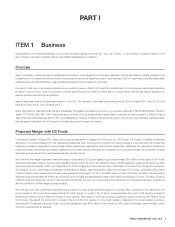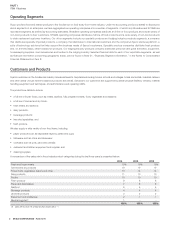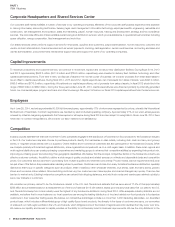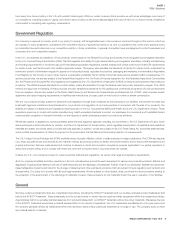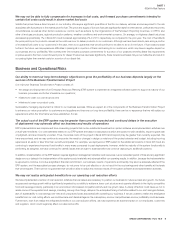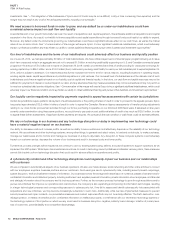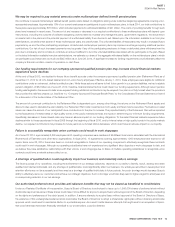Sysco 2014 Annual Report Download - page 21
Download and view the complete annual report
Please find page 21 of the 2014 Sysco annual report below. You can navigate through the pages in the report by either clicking on the pages listed below, or by using the keyword search tool below to find specific information within the annual report.
SYSCO CORPORATION-Form10-K 9
PARTI
ITEM1ARisk Factors
We may not be able to fully compensate for increases in fuel costs, and forward purchase commitments intended to
contain fuel costs could result in above market fuel costs
Volatile fuel prices have a direct impact on our industry. We require signi cant quantities of fuel for our delivery vehicles and are exposed to the risk
associated with uctuations in the market price for fuel. The price and supply of fuel can uctuate signi cantly based on international, political and economic
circumstances, as well as other factors outside our control, such as actions by the Organization of the Petroleum Exporting Countries, or OPEC, and
other oil and gas producers, regional production patterns, weather conditions and environmental concerns. On average, on-highway diesel fuel prices
decreased approximately 1% in scal 2014 and increased approximately 2% in 2013, respectively, as compared to the prior year. The cost of fuel affects
the price paid by us for products, as well as the costs we incur to deliver products to our customers. Although we have been able to pass along a portion
of increased fuel costs to our customers in the past, there is no guarantee that we will continue to be able to do so in the future. If fuel costs increase
further in the future, we may experience dif culties in passing all or a portion of these costs along to our customers, which may have a negative impact on
our business and our pro tability. We routinely enter into forward purchase commitments for a portion of our projected monthly diesel fuel requirements
at prices equal to the then-current forward price for diesel. If fuel prices decrease signi cantly, these forward purchases may prove ineffective and result in
our paying higher than market costs for a portion of our diesel fuel.
Business and Operational Risks
Our ability to meet our long-term strategic objectives to grow the pro tability of our business depends largely on the
success of the Business Transformation Project
Our multi-year Business Transformation Project consists of:
•
the design and deployment of an Enterprise Resource Planning (ERP) system to implement an integrated software system to support a majority of our
business processes and further streamline our operations;
•initiatives to lower our cost structure; and
•initiatives to lower our product costs.
Successfully managing deployment is critical to our business success. While we expect all of the components of the Business Transformation Project
to enhance our value proposition to customers and suppliers and improve our long-term pro tability, there can be no assurance that we will realize our
expectations within the time frame we have established, if at all.
The actual cost of the ERP system may be greater than currently expected and continued delays in the execution
ofdeployment may adversely affect our business and results of operations
ERP implementations are complex and time-consuming projects that involve substantial investments in system software and implementation activities over
a multi-year timeframe. Our cost estimates related to our ERP system are based on assumptions which are subject to wide variability, require a great deal
of judgment, and are inherently uncertain. Thus, the actual costs of the project in scal 2015 (and beyond) may be greater than currently expected. We
have encountered, and we may continue to encounter, the need for changes in design or revisions of the project calendar and budget, including incurring
expenses at an earlier or later time than currently anticipated. For example, we deployed our ERP system to ve additional locations in scal 2014 and are
continuing to experience improved functionality in many areas compared to past deployments; however, while the majority of the system functionality is
performing as designed, we have continued to identify issues that we want to address before we continue deploying to additional locations.
In addition, implementation of the ERP system requires signi cant management attention and resources over an extended period of time and any signi cant
design errors or delays in the implementation of the systems could materially and adversely affect our operating results. In addition, because the implementation
is expected to continue to involve a signi cant nancial commitment, our business, results of operations and liquidity may also be adversely affected if the
ERP system, and the associated process changes, do not prove to be cost effective or do not result in the cost savings and other bene ts at the levels
that we anticipate. There can be no guarantee that we will be able to realize the intended results of the system software and implementation activities.
We may not realize anticipated bene ts from our operating cost reduction efforts
We have implemented a number of cost reduction initiatives that we believe are necessary to position our business for future success and growth. Our future
success and earnings growth will be signi cantly impacted by our ability to achieve a lower cost structure and operate ef ciently in the highly competitive
food and beverage industry, particularly in an environment of increased competitive activity and low growth rates. A variety of factors could cause us not to
realize some of the expected cost savings, including, among other things, delays in the anticipated timing of activities related to our cost savings initiatives,
lack of sustainability in cost savings over time and unexpected costs associated with operating our business. If we are unable to realize the anticipated
bene ts from our cost cutting efforts, we could become cost disadvantaged in the marketplace, and our competitiveness and our pro tability could decrease.
Furthermore, even if we realize the anticipated bene ts of our cost reduction efforts, we may experience an adverse impact on our employees, customers
and suppliers, which could negatively affect our sales and pro ts.




